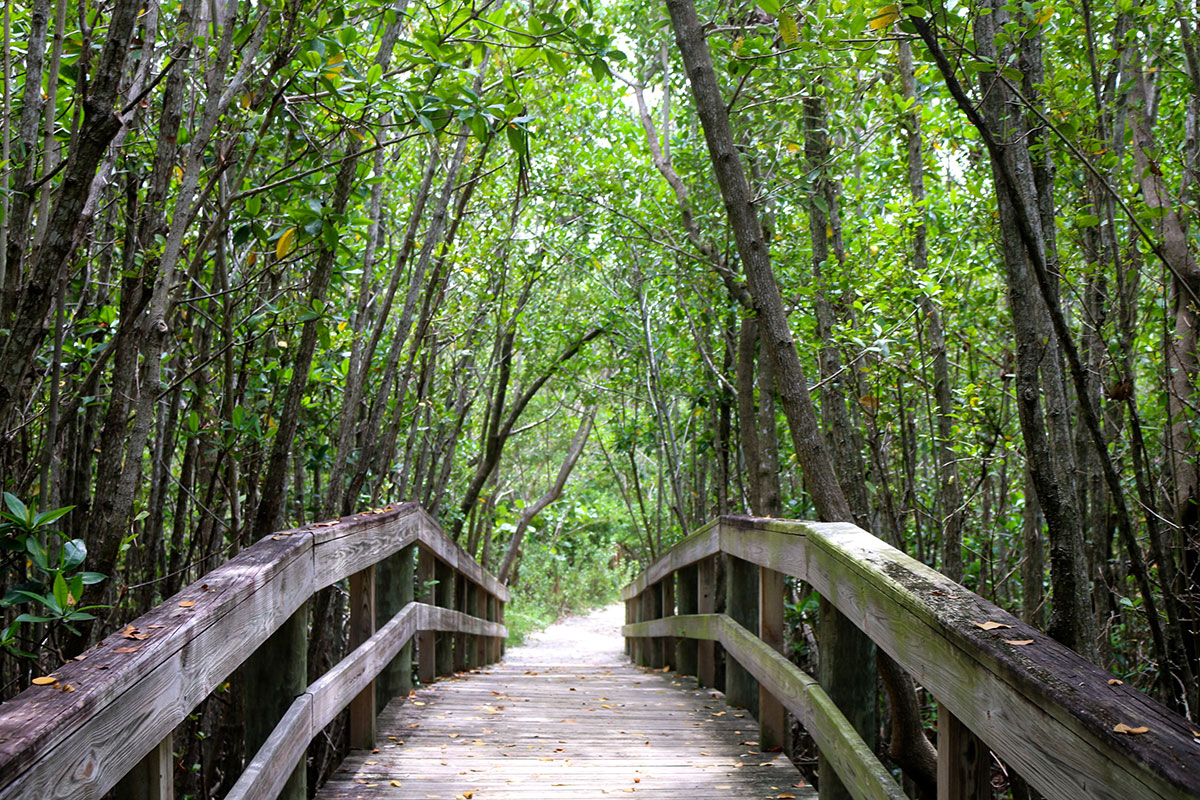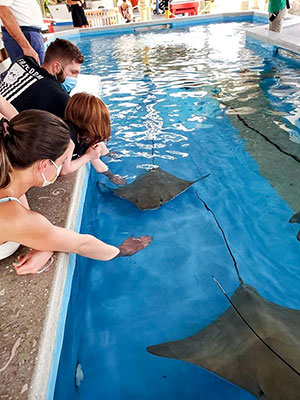Ocean EcoCenter tells the story of Florida’s water

New oceanographic center unfolds the story of Florida’s water
BY DONNA CRARY
If you’re looking for a fun and educational outing this summer, drive to the Florida Oceanographic Coastal Center on South Hutchinson Island in Stuart. The marine life nature center is a popular destination that is designed to inspire visitors to appreciate and take care of the environment. The 57-acre site provides a variety of displays, aquariums, live animal exhibits and nature trails that educate and entertain people of all ages.
And this month, the Florida Oceanographic Society will offer more exciting opportunities when its new Ocean EcoCenter opens. Visitors to the 27,000-square-foot center can learn about protecting Florida’s coastal ecosystems through interactive exhibits, play-based learning activities and educational programs.
“The center teaches about Florida’s water story — how is the water in South Florida set up?” explains Mark Perry, executive director of the Florida Oceanographic Society. “It’s a great place to come and learn about the area, but also understand the water ecology of the area through the estuaries, the life along the shore, the connection to the coastal environment, and out into the coral reef systems.”

The exhibits are set up so guests can take a walking tour that mimics the flow of water from a freshwater river through an estuary out past the beaches into the ocean.
The first gallery features estuaries of the Indian River Lagoon. The lagoon is ideally located between the temperate and tropical zones making it the most biodiverse habitat in North America. Estuaries are water bodies where saltwater and freshwater converge, and they are home to thousands of animal species. Aquariums are on display in the gallery that depict a mangrove forest, an oyster reef and a seagrass meadow, which are typically found in estuaries.
“A part of our message is that these estuaries are key to these animals’ life cycles,” Perry says. “So they begin to spawn in the inlet area, and in the juvenile stages they are harbored in the seagrass. Imagine yourself as a little fish trying to find food and shelter. You’re in the seagrass and you can find the algae to eat and the different predators to hide from. It gives them a chance to grow up.”

BEACHES, REEFS HIGHLIGHTED

The Life Along the Shore gallery portrays the beaches and near shore reefs along the Treasure Coast. Visitors learn about sea turtles, wading birds, and the tiny Sabellariid worm that creates its intricate work of animal architecture.
“If you’ve been to Bathtub Reef Beach, the reef you see is not made by coral, like most of Florida’s reefs,” explains Zack Jud, director of Education and Exhibits of Florida Oceanographic Society. “It’s actually built by tiny worms. We’ve created an exact replica of this reef in one of our new aquariums to help share the story of why it’s so unique and important. It’s arguably the largest readily accessible worm reef in the United States.”
As guests leave near-shore waters, they enter the Ocean Connections gallery and explore Florida’s reef track and move outward to the Atlantic. They learn about the Gulf Stream, the warm ocean current that hugs the Florida coast. It brings countless juvenile animals born farther south into local waters and it becomes their first home.
The display area includes a tilt-a-table exhibit that demonstrates how water navigates from the headwaters of the Everglades south to Florida Bay. The interactive exhibit invites visitors to move little ball bearings representing droplets of water through a maze. The game teaches about the pitfalls of Florida’s drainage problems and its impact on the local environment.
The Ocean EcoCenter also has an Exploration Lab, a flexible space that provides many ways to learn about marine life on the Treasure Coast. Guests can get hands-on instruction accessing microscopes, puzzles, matching games, sound-related games, coloring stations and more. Terrariums and aquariums will be set up to house unique organisms. A magnetic mural will allow visitors to create their own estuary scene. The lab will also be a center for engaging science lectures and workshops.

VIEW FROM HIGH ABOVE
At the top of the Ocean EcoCenter is the Ocean Deck — a spacious covered open area on the third floor that offers spectacular vistas of the ocean and the Indian River. The Ocean Deck will be made available to the public for special events.
As visitors walk outside the Ocean EcoCenter, they come across an expansive 750,000-gallon aquamarine lagoon that’s filled with nonreleasable sea turtles, nurse sharks, snook, tarpon and other types of gamefish. These animals serve as conservation ambassadors giving reminders about the necessity of protecting local waterways.
“We want to make sure that guests aren’t just looking at animals, but also learning why they are important,” Jud explains. “We talk about animals that are sentinels for the health of the ecosystem. And then we talk about what’s being done to try and fix environmental problems. Creating that personal connection often is what leads people to go home with the ambition to make changes in their own life.”

Near the gamefish lagoon are the stingray and the invertebrate touch tank exhibits. Guests interact with stingrays they can touch and feed. Children are especially impressed when they handle a stingray, hermit crab or sea urchin for the first time.
“They overcome that fear and say, ‘Oh my God! That’s exciting! Where does it live? What does it eat? How can I take care of it?’ ”says Perry. “That’s when I say we’re doing our job. We’re a part of this world and you’ve got to understand it and your connection to it. Once you do, we’ve got them. Basically, children are our future advocates to help protect it.”
A LEARNING EXPERIENCE

The Florida Oceanographic Society provides a wide assortment of educational programs for young and old alike. Six presentations that inspire environmental stewardship are given daily at the center. The nonprofit’s Coastal Lecture Series is held during winter months. Scientists lecture on a variety of topics including sea turtles, sharks, blue-green algae blooms, intensification of hurricanes and environmental history stories. And if you cannot attend in person, the lectures are recorded so you can view them online.
The center is a valuable educational outreach for the area’s K-12 students. Jud says the center coordinates with teachers to develop field trips and live, online programs that reinforce various topics that are taught in the classroom. It also receives grants so it can provide field trips for the region’s underserved.
“On a regular basis, we have teachers who let us know that some of their students have never seen the ocean,” Jud says. “They live 10 miles from the beach in St. Lucie or Martin County. So we get them out here touching a stingray or interacting with a sea cucumber, and those are life-changing experiences for kids. We don’t expect every student to become a scientist. We just want them to become conscientious citizens.”
The nonprofit also partners with and provides educational programs to colleges across the country and around the world. Students come to the center to complete internships or work on research projects in animal life support and conservation efforts. The center streams live lessons and educational webinars in university lecture halls.
Additionally, during the summer months the center offers fishing clinics for children, snorkeling and marine science summer camps. Older children and adults can enjoy the educational beach walks, nature trail walks and well-attended turtle walks where guests can get up close and watch a mother sea turtle dig a nest and lay its eggs.

As Perry looks around at the new Ocean EcoCenter, he’s excited that the expansion will make a positive impact on area waterways. In recent years, the discharges from Lake Okeechobee and the resulting algae blooms have devastated the Indian River Lagoon. Perry stresses that getting the message out to protect this fragile ecosystem is more important than ever.
“During a visit to the Coastal Center, we teach people about the animals that live locally and about the problems that are affecting our local waterways,” he says. “We hope that when people leave here, they have a new appreciation for what’s wrong, but also a new knowledge about what they can do to make a difference to try and help.”
